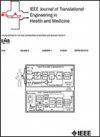Videographic-Free Tracking of Hyoid Bone Displacement During Swallowing Using Accelerometer Signals and Transformers
IF 4.4
3区 医学
Q2 ENGINEERING, BIOMEDICAL
IEEE Journal of Translational Engineering in Health and Medicine-Jtehm
Pub Date : 2025-08-22
DOI:10.1109/JTEHM.2025.3601988
引用次数: 0
Abstract
Objective: Accurate tracking of anatomical landmarks during swallowing is critical for early diagnosis and treatment of dysphagia. Hyoid bone displacement plays a pivotal role in upper esophageal sphincter opening and airway protection, traditionally assessed via a videofluoroscopic swallow study (VFSS). However, VFSSs are subjective, expose patients to radiation, and are not universally accessible. High-resolution cervical auscultation (HRCA) offers a noninvasive alternative, utilizing acoustic and vibratory signals. Prior studies have validated HRCA’s efficacy in analyzing swallowing kinematics and correlating with hyoid bone displacement, typically employing transform domain characteristics and recurrent neural networks to achieve 50% overlap in predicted displacementsMethods: We introduce a transformer-based architecture for tracking hyoid bone displacement directly from raw HRCA signals, leveraging advanced temporal and spatial feature extraction methods using attention mechanism. The proposed pipeline preprocesses HRCA signals, segments individual swallows, and tracks the hyoid bone.Results: Our approach significantly improves upon existing methods, achieving over 70% relative overlap in predicted hyoid bone displacements across validation folds, surpassing state-of-the-art baseline models by a margin of at least 20%. Comprehensive statistical analysis confirms the robustness and accuracy of our predictions, demonstrating strong generalization capabilities on an independent dataset.Conclusion: This novel approach underscores the potential of transformer models in promoting noninvasive dysphagia assessment, offering a precise tracking of hyoid bone without VFSS images, and providing clinicians with insights about its movement trends, potentially aiding in clinical decision-making and bringing us one step closer to automated noninvasive swallowing assessment protocols. Clinical Impact– This study highlights the potential of automated hyoid bone tracking using HRCA signals to enhance dysphagia assessment by providing objective, noninvasive measurements that potentially support earlier detection and monitoring of swallowing impairments in both clinical and home healthcare settings, ultimately improving patient management and treatment outcomes.利用加速度计信号和变压器对吞咽过程中舌骨位移的无摄像跟踪
目的:准确追踪吞咽过程中的解剖标志对吞咽困难的早期诊断和治疗至关重要。舌骨移位在食管上括约肌打开和气道保护中起着关键作用,传统上通过视频透视吞咽研究(VFSS)进行评估。然而,vfss是主观的,使患者暴露于辐射中,并不是普遍可获得的。高分辨率宫颈听诊(HRCA)提供了一种非侵入性的选择,利用声学和振动信号。先前的研究已经验证了HRCA在分析吞咽运动学和与舌骨位移相关方面的有效性,通常使用变换域特征和递归神经网络来实现预测位移的50%重叠。方法:我们引入了一个基于变压器的架构,直接从原始HRCA信号中跟踪舌骨位移,利用先进的时空特征提取方法利用注意机制。提出的管道预处理HRCA信号,分割单个燕子,并跟踪舌骨。结果:我们的方法显著改进了现有方法,在验证折叠中预测舌骨移位的相对重叠超过70%,超过最先进的基线模型至少20%。综合统计分析证实了我们预测的稳健性和准确性,在独立数据集上展示了强大的泛化能力。结论:这种新方法强调了变形模型在促进无创吞咽困难评估方面的潜力,提供了没有VFSS图像的舌骨精确跟踪,并为临床医生提供了关于其运动趋势的见解,可能有助于临床决策,使我们更接近自动化的无创吞咽评估方案。临床影响:本研究强调了使用HRCA信号进行舌骨自动跟踪的潜力,通过提供客观、无创的测量,可能支持临床和家庭医疗环境中吞咽障碍的早期检测和监测,从而增强吞咽困难的评估,最终改善患者管理和治疗结果。
本文章由计算机程序翻译,如有差异,请以英文原文为准。
求助全文
约1分钟内获得全文
求助全文
来源期刊

IEEE Journal of Translational Engineering in Health and Medicine-Jtehm
Engineering-Biomedical Engineering
CiteScore
7.40
自引率
2.90%
发文量
65
审稿时长
27 weeks
期刊介绍:
The IEEE Journal of Translational Engineering in Health and Medicine is an open access product that bridges the engineering and clinical worlds, focusing on detailed descriptions of advanced technical solutions to a clinical need along with clinical results and healthcare relevance. The journal provides a platform for state-of-the-art technology directions in the interdisciplinary field of biomedical engineering, embracing engineering, life sciences and medicine. A unique aspect of the journal is its ability to foster a collaboration between physicians and engineers for presenting broad and compelling real world technological and engineering solutions that can be implemented in the interest of improving quality of patient care and treatment outcomes, thereby reducing costs and improving efficiency. The journal provides an active forum for clinical research and relevant state-of the-art technology for members of all the IEEE societies that have an interest in biomedical engineering as well as reaching out directly to physicians and the medical community through the American Medical Association (AMA) and other clinical societies. The scope of the journal includes, but is not limited, to topics on: Medical devices, healthcare delivery systems, global healthcare initiatives, and ICT based services; Technological relevance to healthcare cost reduction; Technology affecting healthcare management, decision-making, and policy; Advanced technical work that is applied to solving specific clinical needs.
 求助内容:
求助内容: 应助结果提醒方式:
应助结果提醒方式:


